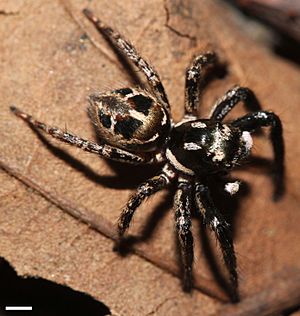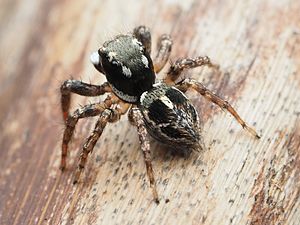Anasaitis canosa facts for kids
Quick facts for kids Anasaitis canosa |
|
|---|---|
 |
|
| Male Anasaitis canosa | |
 |
|
| Female Anasaitis canosa | |
| Scientific classification |
Anasaitis canosa, also known as the twin-flagged jumping spider, is a small spider. You can often find it on leaves on the ground or on human-made things like fences and walls. It gets its common name from two flag-shaped marks on its back, near its head. These marks are made of shiny "scales" that can look white, green, or pink. Male spiders also have these shiny scales on their front leg-like parts called pedipalps, which they use to attract females. This tiny spider is only about 5 to 6 millimeters long, which is roughly the size of a pencil eraser! You can find Anasaitis canosa from Mexico all the way to South Carolina, mostly near the Gulf of Mexico.
How the Twin-Flagged Jumping Spider Hunts
This spider has a very special way to hunt ants. First, the spider turns its body to face the ant. Then, it moves sideways in a curve until the ant is looking right at it. Once they are face-to-face, the spider quickly jumps. It bites the ant on the top of its head or body. This way, the ant's dangerous jaws and stinger cannot hurt the spider.
When hunting other prey, like flies or beetles, this jumping spider is much more direct. It will pounce and bite from any direction. This is probably because these insects are less risky for the spider to catch. Like other jumping spiders, Anasaitis canosa always uses a silk safety line when it jumps. If it misses its target, it can climb back up this silk line to where it started.
Spider Reproduction and Babies
Female twin-flagged jumping spiders lay their eggs inside a silk nest. They stay and guard the eggs until they hatch. A female usually lays about fifteen spiderlings (baby spiders) each time she reproduces.
Male spiders have a special dance to attract females. They hold their front pair of legs out to the sides. These legs are darker in color. The male then moves to face the female directly. When he is close enough, he uses these legs to gently touch the female on her back.

